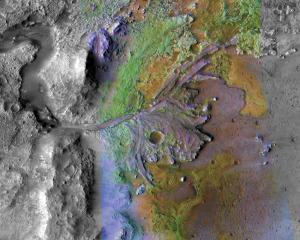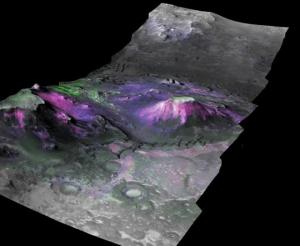A 3-D image of a trough in the Nili Fossae region of Mars shows phyllosilcates (in magenta and blue hues) on slopes of mesas and canyon walls, showing water played a role in Mars’ past.
For all the Mars romanticists out there, we (yes, that means me, too) hope and maybe even dream that Mars once harbored water. And not just a little spurt of groundwater every once in awhile; we want the water to have been there in abundance and for enough time to make an impact on the planet and its environment. Now, proof of copious amounts of water in Mars’ past may have been found. Two new papers based on data from the Mars Reconnaissance Orbiter (MRO) found that vast regions of the ancient southern highlands of Mars hosted a water-rich environment, and that water played a sizable role in changing the minerals of a variety of terrains in the Noachian period – about 4.6 billion to 3.8 billion years ago.
John Mustard, a professor of planetary geology at Brown University and deputy principal investigator for the Compact Reconnaissance Imaging Spectrometer for Mars (CRISM) on MRO investigated the pervasive presence of phyllosilicates, clay-like minerals that preserve a record of water’s interaction with rocks.
Specifically, Mustard and his team from 13 other institutions focused on phyllosilicate deposits in areas like craters, valleys and dunes all over the planet. Among the highlights, he detected the clay-like minerals in fans and deltas within three regions, most notably the Jezero crater. That discovery marks the first time hydrated silicates have been found in sediments “clearly lain by water,†Mustard said.
The team also found phyllosilicate deposits in thousands of places in and around craters, including the pointed peaks located at the center of some of the depressions. This suggests that water was present 4-5 kilometers below the ancient Martian surface, the team wrote, due to the generally accepted principle that crater-causing collisions excavate underground minerals that are then exposed on the crater peaks.
“Water must have been creating minerals at depth to get the signatures we see,†Mustard said.
The clay minerals were formed at low temperatures (100-200°C) – an important clue to understanding the Red Planet’s potential for habitability during the Noachian period.
“What does this mean for habitability? It’s very strong,†Mustard said. “It wasn’t this hot, boiling cauldron. It was a benign, water-rich environment for a long period of time.â€

In another paper, graduate student Bethany Ehlmann and colleagues from Brown and other institutions analyzed sediment deposits in two exquisitely preserved deltas in the Jezero crater, which held an ancient lake slightly larger than Lake Tahoe. The deltas suggest a flow from rivers carrying the clay-like minerals from an approximate 15,000-square kilometer watershed during the Noachian period.
Ehlmann said scientists cannot determine whether the river flow was sporadic or sustained, but they do know it was intense and involved a lot of water.
The deltas appear to be excellent candidates for finding stored organic matter, Ehlmann said, because the clays brought in from the watershed and deposited in the lake would have trapped any organisms, leaving in essence a cemetery of microbes.
“If any microorganisms existed on ancient Mars, the watershed would have been a great place to live,†Ehlmann said. “So not only was water active in this region to weather the rocks, but there was enough of it to run through the beds, transport the clays and run into the lake and form the delta,†she said.
Original News Source: Brown University Press Release


I’m feeling more and more like life in this solar system did not originate on earth!
What do you guys think was there an ancient civilization that sent its last hope of life in a capsule to our oceans in hope of spawning a new branch of itself.wweeeiiirrrddd!!!!!
We spreading out our knowledge when concentration in details are paramount.
I was working enhancing and reconstructing some questionable structure on Mars, to find out that, but of the huge head, most of the ones spread all over are optical illusions, Yet working on one in particular, I found something really dramatic. I saw two wheels and a head between them. Well after enhancing, they turned to be three wheels of the same size. Check it out in utube
http://www.youtube.com/watch?v=MJBowLFBf2A
There are some many weird subjects on the Martian terrain, but two typical forms repeat and repeat themselves, spheres and wheels.
This makes me wonder where all the water went? I wonder what caused Mar’s to become dry? Could the water be under Mar’s surface? Will Earth eventually have the same fate as Mars?
“Not a boiling cauldron” … Doesn’t water boil at sea level on earth at 100°C. 100-200°C seems like a boiling cauldron, perhaps like the hot springs on earth (Iceland and Yellowstone Park).
I badly want this to be signs of water, but due to the current climate and location of Mars, I’m not ready to even hint water was on mars. There are other things it could be; high wind on many areas.
It would be nice to see a better relief map showing altitude changes along all these points. I’d like to figure out which branches are caused from possibly moving water towards the center and which branches are caused from possible expansion.
The slopes of many of the branches seem a bit odd to me. Wouldn’t be as shocking if the water or whatever contained in them was mostly stagnant, but if it was moving/mobile, it is definitely strange to me. Although there are other reasons it is like this… sandstorms etc can change the shape of things dramatically.